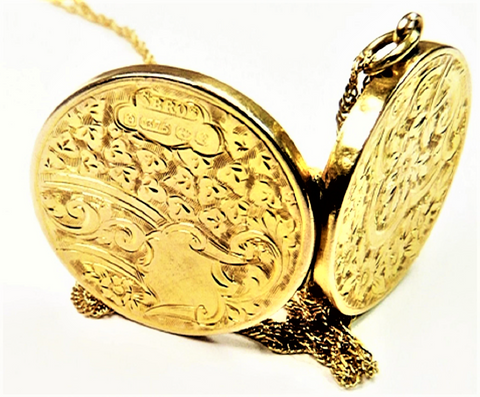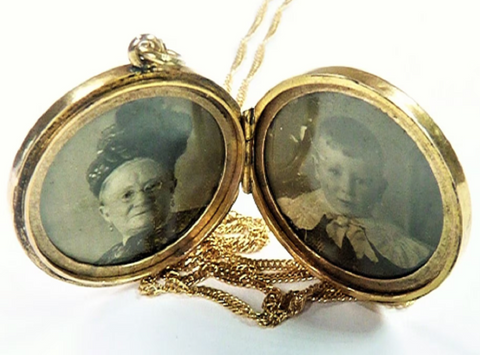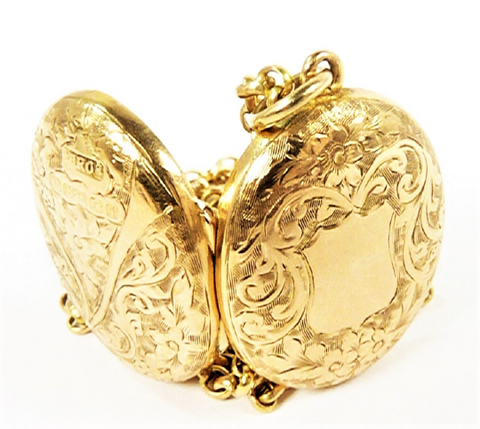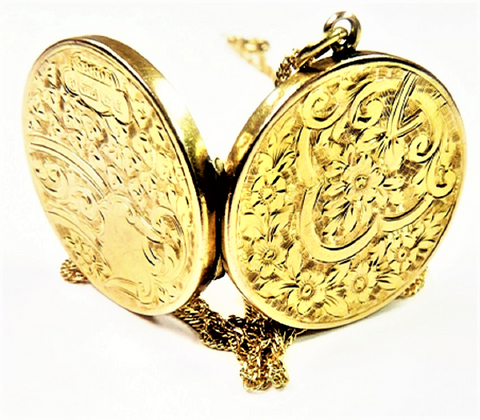#Goldsmiths #Sheldon #Brothers #Antique #Gold #Lockets
.
Sheldon Brothers began trading in 1881.
The firm operated from buildings located in the heart of the London & Birmingham jewellery quarters.
In the Victorian era their business premises were listed as 6 Vyse Street, Birmingham and 65 Hatton Garden, London, EC.
In 1892 the firm is listed as:
Manufacturing Silversmiths.
Specialities in silver hall-marked goods.
Sugars, Tongs, Creams, Jugs, Muffineers, Serviette Rings, Flower Vases, Puff Boxes, etc., etc.
A muffineer is a small container with a pierced top.
Wealthy Victorian households would most likely own muffineers crafted from ornately embellished high grade silver.
The name derives from its early use for sprinkling sugar or cinnamon on muffins.
Charles Thomas & William Samuel Sheldon traded as Sheldon Brothers.
In the early Edwardian era the company was advertised as:
Manufacturing Jewellers …
Brooches, Earrings, Bracelets, Bangles, Lockets, Pins & H.M.,
9 & 15ct, Gold and Silver in all the Latest Designs.
The abbreviation H.M. represents the word hallmarked.
A splendid and ornately embellished Art Nouveau gold locket. This delightful Edwardian antique pendant locket is fully hallmarked. In 1905 this piece was assayed for purity at Birmingham Assay Office. The front is ornamented with forget-me-nots.

IVY LEAVES & SCROLL CARTOUCHE
Ivy leaves grace the back. Ivy has symbolised fidelity, deep friendship and wedded bliss for many generations. A scroll cartouche features on the back. Scrolls symbolise wisdom and direction. This antique pendant was crafted by Sheldon Brothers.
More beautiful fully hallmarked antique gold lockets.
In 1907 the firm relocated its London offices to 16 Colonial Buildings, Hatton Garden.
We have found that Sheldon Brothers hallmarked gold lockets are of a very high standard.

ORIGINAL PHOTOGRAPHS
The interior case contains the original and very charming photographs.
If you are wondering why you almost never see photographs from this era of people smiling it is because the subjects of the photographs may have to hold their pose for more than ten minutes. It would not have been possible to hold a smile for a long period of time.
In the Edwardian era only well off families could afford to employ a photographer. Often photographers would be called out to a residence to photograph the family.
As you can imagine this would be a costly endeavour, especially when the photographs were commissioned to be fitted in a newly purchased gold locket of exceptional quality.
Sometimes the keepsake locket would contain portraits of deceased relatives or maybe family members who were away travelling or fighting in a foreign land.
It may have been many months before they would be seen again, if at all.

EDWARDIAN 15 CARAT GOLD KEEPSAKE LOCKET NECKLACE
An elegant fully hallmarked 15 carat gold Edwardian locket which was crafted by Sheldon Brothers in 1908.
This delightful double portrait locket is suspended from a splendid barrel clasp 15 carat gold necklace.
Both sides of this stunning portrait locket are embellished with forget-me-nots which symbolise deep respect and love. The shield shaped cartouche is framed by florid acanthus leaves. The shield represents the desire to protect the wearer of the locket. Acanthus leaves also adorn the other side. They have been used to convey everlasting life since ancient times.

VIEW THIS ORNATE EDWARDIAN SHELDON BROTHERS LOCKET
A splendid Edwardian antique fully hallmarked solid gold portrait locket which was assayed* (tested for purity*) at Birmingham Assay Office in 1908. Both sides are embellished with acanthus leaves and forget-me-nots.

GEORGE V SHELDON BROTHERS 9CT GOLD LOCKET NECKLACE
The most delightful and deeply symbolic fully hallmarked antique 9 carat rose gold locket which was crafted by Sheldon Brothers and assayed at Birmingham in 1913.
The locket is paired with an elegant 16 inch fully hallmarked 9 carat rose gold belcher chain necklace. The front and back of the locket are ornamented in the most beautiful way. Garlands of roses adorn both sides. Two swallows are also depicted.
The locket is round in shape. However, the expert rendering of the form makes each side also have the appearance of a Celtic style cross.
Roses represent love, honour, hope, joy, faith, beauty and timelessness.
Swallows are a good luck charm that are said to give the wearer a safe journey and return home.
Information regarding this maker is relatively scarce.
If we find more we will update this post.
More fabulous fully hallmarked antique gold lockets.




